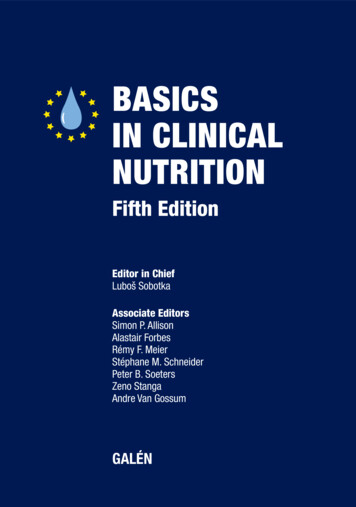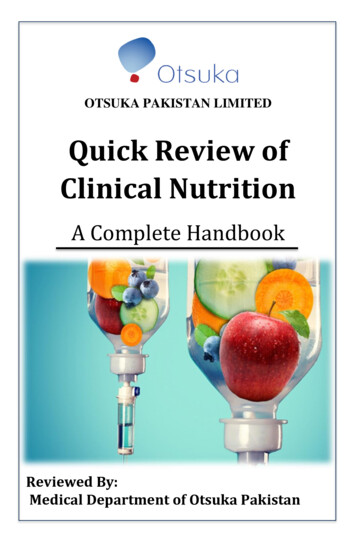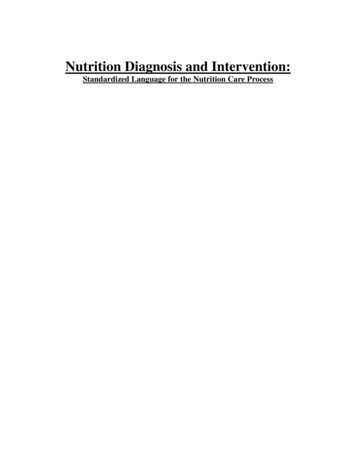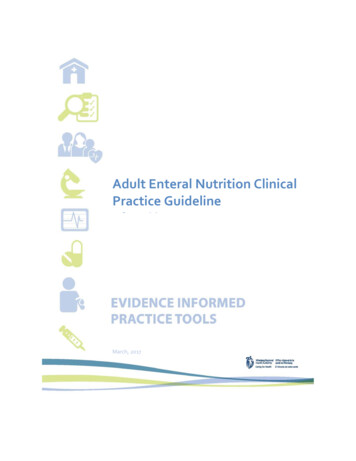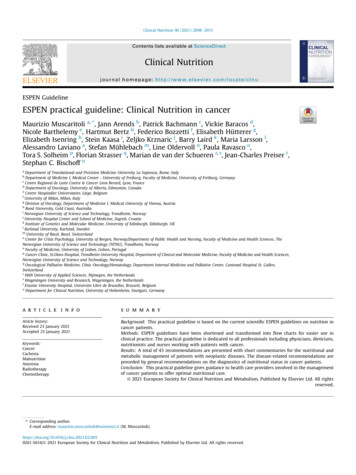
Transcription
Clinical Nutrition 40 (2021) 2898e2913Contents lists available at ScienceDirectClinical Nutritionjournal homepage: http://www.elsevier.com/locate/clnuESPEN GuidelineESPEN practical guideline: Clinical Nutrition in cancerMaurizio Muscaritoli a, *, Jann Arends b, Patrick Bachmann c, Vickie Baracos d,Nicole Barthelemy e, Hartmut Bertz b, Federico Bozzetti f, Elisabeth Hütterer g,Elizabeth Isenring h, Stein Kaasa i, Zeljko Krznaric j, Barry Laird k, Maria Larsson l,Alessandro Laviano a, Stefan Mühlebach m, Line Oldervoll n, Paula Ravasco o,Tora S. Solheim p, Florian Strasser q, Marian de van der Schueren r, s, Jean-Charles Preiser t,Stephan C. Bischoff uaDepartment of Translational and Precision Medicine University La Sapienza, Rome, ItalyDepartment of Medicine I, Medical Center - University of Freiburg, Faculty of Medicine, University of Freiburg, GermanycCentre Regional de Lutte Contre le Cancer Leon Berard, Lyon, FrancedDepartment of Oncology, University of Alberta, Edmonton, CanadaeCentre Hospitalier Universitaire, Liege, BelgiumfUniversity of Milan, Milan, ItalygDivision of Oncology, Department of Medicine I, Medical University of Vienna, AustriahBond University, Gold Coast, AustraliaiNorwegian University of Science and Technology, Trondheim, NorwayjUniversity Hospital Center and School of Medicine, Zagreb, CroatiakInstitute of Genetics and Molecular Medicine, University of Edinburgh, Edinburgh, UKlKarlstad University, Karlstad, SwedenmUniversity of Basel, Basel, SwitzerlandnCenter for Crisis Psychology, University of Bergen, Norway/Department of Public Health and Nursing, Faculty of Medicine and Health Sciences, TheNorwegian University of Science and Technology (NTNU), Trondheim, NorwayoFaculty of Medicine, University of Lisbon, Lisbon, PortugalpCancer Clinic, St.Olavs Hospital, Trondheim University Hospital, Department of Clinical and Molecular Medicine, Faculty of Medicine and Health Sciences,Norwegian University of Science and Technology, NorwayqOncological Palliative Medicine, Clinic Oncology/Hematology, Department Internal Medicine and Palliative Center, Cantonal Hospital St. Gallen,SwitzerlandrHAN University of Applied Sciences, Nijmegen, the NetherlandssWageningen University and Research, Wageningen, the NetherlandstErasme University Hospital, Universite Libre de Bruxelles, Brussels, BelgiumuDepartment for Clinical Nutrition, University of Hohenheim, Stuttgart, Germanyba r t i c l e i n f os u m m a r yArticle history:Received 23 January 2021Accepted 23 January 2021Background: This practical guideline is based on the current scientific ESPEN guidelines on nutrition incancer patients.Methods: ESPEN guidelines have been shortened and transformed into flow charts for easier use inclinical practice. The practical guideline is dedicated to all professionals including physicians, dieticians,nutritionists and nurses working with patients with cancer.Results: A total of 43 recommendations are presented with short commentaries for the nutritional andmetabolic management of patients with neoplastic diseases. The disease-related recommendations arepreceded by general recommendations on the diagnostics of nutritional status in cancer patients.Conclusion: This practical guideline gives guidance to health care providers involved in the managementof cancer patients to offer optimal nutritional care. 2021 European Society for Clinical Nutrition and Metabolism. Published by Elsevier Ltd. All AnorexiaRadiotherapyChemotherapy* Corresponding author.E-mail address: maurizio.muscaritoli@uniroma1.it (M. 2.0050261-5614/ 2021 European Society for Clinical Nutrition and Metabolism. Published by Elsevier Ltd. All rights reserved.
M. Muscaritoli, J. Arends, P. Bachmann et al.Clinical Nutrition 40 (2021) 2898e2913selected by ESPEN to include a range of professions and fields ofexpertise. The guideline process was commissioned and financiallysupported by ESPEN and by the European Partnership for ActionAgainst Cancer (EPAAC), an EU level initiative. The guidelineshortage and dissemination was funded in part by the United European Gastroenterology (UEG) society, and also by the ESPEN society. For further details on methodology, see the full version of theESPEN guideline [1] and the ESPEN framework for disease-specificguidelines [2]. The ESPEN practical guideline “Clinical Nutrition inCancer” has been structured according to a flow chart covering allnutritional aspects of cancer (Fig. REERIGTEETHCbody mass indexenteral nutritionenhanced recovery after surgerygastrointestinalb-Hydroxy-b-methyl butyratehematopoietic stem cell transplantationNon-steroidal anti-inflammatory drugoral nutritional supplementspercutaneous endoscopic gastrostomiesparenteral nutritionrandomized controlled trialresting energy expenditureradiologically inserted gastrostomiestotal energy expenditureTetrahydrocannabinol3. General concepts of treatment relevant to all cancerpatients3.1. Screening and assessment (Fig. 2)1) To detect nutritional disturbances at an early stage, we recommend to regularly evaluate nutritional intake, weight change,and body mass index (BMI), beginning with cancer diagnosisand repeated depending on the stability of the clinical situation.(Recommendation B1-1; strength of recommendation strong elevel of evidence very low e strong consensus)2) In patients with abnormal screening, we recommend objectiveand quantitative assessment of nutritional intake, nutritionimpact symptoms, muscle mass, physical performance and thedegree of systemic inflammation. (Recommendation B1-2;strength of recommendation strong e level of evidence verylow e consensus)1. IntroductionNeoplastic diseases represent the second leading cause of deathworldwide and the number of new cases is expected to rise significantly over the next decades. Malnutrition is a common feature incancer patients and is the consequence of both the presence of thetumor and the medical and surgical anticancer treatments. Malnutrition negatively impacts on quality of life and treatment toxicities,and it has been estimated that up to 10e20% of cancer patients diedue to consequences of malnutrition rather than for the tumor itself.Thus, nutrition plays a crucial role in multimodal cancer care. Robustevidence indicates that nutritional issues should be taken into account since the time of cancer diagnosis, within a diagnostic andtherapeutic pathway, and should be running in parallel to antineoplastic treatments. However, worldwide, cancer-related malnutritionis still largely unrecognized, underestimated and undertreated inclinical practice,. These evidence-based guidelines were developedto translate current best evidence and expert opinion into recommendations for multi-disciplinary teams responsible for the identification, prevention, and treatment of reversible elements ofmalnutrition in adult cancer patients.3.2. Energy and substrate requirements3) We recommend that the total energy expenditure (TEE) ofcancer patients, if not measured individually, be assumed to besimilar to healthy subjects and generally ranging between 25and 30 kcal/kg/day. (Recommendation B2-1; strength ofrecommendation strong e Level of evidence low e consensus)CommentaryIt is well known that an insufficient diet leads to chronicmalnutrition. To maintain a stable nutritional state, the diet has tomeet the patient's energy requirements which are the sum of theresting energy expenditure (REE), physical activity, and, in a smallpercentage, of diet-induced thermogenesis. In cancer patients, REEdetermined by indirect calorimetry, the gold standard, has beenreported to be unchanged, increased, or decreased in relation tonon-tumor bearing controls [3]. In a large study from the group atLundholm [4], approximately 50% of all cancer patients who werelosing weight were hypermetabolic when compared to appropriatecontrols allowing for similarity in physical activity, body composition, age, and weight loss. Similarly, in newly diagnosed cancerpatients 47% were hypermetabolic and displayed a higher ratio ofmeasured versus predicted REE per kg of fat-free mass [5]. WhileREE is increased in many cancer patients, when TEE is considered,this value appears to be lower in patients with advanced cancerwhen compared to predicted values for healthy individuals themain cause appears to be a reduction in daily physical activity [6,7].In conclusion, it appears sensible to initiate nutrition therapyassuming TEE to be similar to healthy controls. TEE may be estimated from standard formulas for REE and standard values forphysical activity level [7].2. MethodologyThe present practical guideline consists of 43 recommendationsand is based on European Society for Clinical Nutrition and Metabolism (ESPEN) guidelines on nutrition in cancer patients [1]. Theoriginal guideline was shortened by restricting the commentariesto the gathered evidence and literature on which the recommendations are based on. The recommendations were not changed butthe presentation of the content was transformed into a graphicalpresentation consisting of decision-making flow charts whereverpossible. The original guideline was developed based on the ESPENframework for disease-specific guidelines [2] and topics to becovered were decided through several rounds of discussion andmodification, searching for meta-analyses, systematic reviews andcomparative studies based on clinical questions according to thePICO format. The evidence was evaluated and merged to developclinical recommendations using the GRADE method. All recommendations were not only based on evidence but also underwent aconsensus process, which resulted in a percentage of agreement(%). Whenever possible, representatives from different professions(physicians, dieticians, nurses, others) as well as patient representatives were involved. Members of the guideline group were4) We recommend that protein intake should be above 1 g/kg/dayand, if possible up to 1.5 g/kg/day. (Recommendation B2-2;2899
M. Muscaritoli, J. Arends, P. Bachmann et al.Clinical Nutrition 40 (2021) 2898e2913Fig. 1. Structure of the ESPEN practical guideline: “Clinical nutrition in cancer”.Fig. 2. General concepts of treatment relevant to all cancer patients: screening and assessment; energy and substrate requirements.strength of recommendation strong e Level of evidence moderate e strong consensus)somewhat higher quantity amino acids (proteins) than in young,healthy individuals [8]. Data regarding the nutritional quality ofproteins in cancer patients are very scarce [9e11].CommentaryMuscle protein synthesis is not blunted in patients with cancer.Several studies suggest that this process is not impaired and remains responsive to the dietary supply of amino acids, albeit a5) We recommend that vitamins and minerals be supplied inamounts approximately equal to the recommended dailyallowance and discourage the use of high-dose micronutrients2900
M. Muscaritoli, J. Arends, P. Bachmann et al.Clinical Nutrition 40 (2021) 2898e2913in the absence of specific deficiencies. (Recommendation B2-4;strength of recommendation strong e Level of evidence low estrong consensus)is the preferred way to maintain or improve nutritional status. Theadditional use of ONS is advised when an enriched diet is noteffective in reaching nutritional goals. Medical nutrition is indicated if patients are unable to eat adequately (e.g. less than 50% ofthe requirement for more than one week or only 50e75% of therequirement for more than two weeks). If a decision has been madeto feed a patient, we recommend enteral nutrition (EN) if oralnutrition remains inadequate despite nutritional interventions(counseling, ONS), and PN if EN is not sufficient or feasible. Nutritional therapy in cancer patients who are malnourished or at risk ofmalnutrition has been shown to improve body weight and energyintake but not survival [20,21]. In patients undergoing (adjuvant)radiotherapy, there is good evidence that nutritional support improves also some aspects of quality of life [22], but these resultshave not yet been confirmed in patients undergoing chemotherapy[20,23].CommentaryAn estimated 50% of all cancer patients consume complementary or alternative medical products [12]; a large fraction of this isaccounted for by multivitamin supplements.Deficiency of vitamin D has been associated with cancer incidence [13] but a meta-analysis of 40 randomized controlled trials(RCTs) reported that vitamin D supplementation with or withoutcalcium did not reduce skeletal or non-skeletal outcomes in unselected community-dwelling individuals by more than 15% [14].Other systematic reviews arrived at a similar conclusion [15].In an RCT 14,641 US physicians combined supplementation withvitamin E (400 IU/day) and vitamin C (500 mg/day) for an averageof ten years was without any effect on cancer incidence [16].Neither long-term supplementation with vitamin E (400 IU/day)nor selenium (200 mg from selenomethionine) had a beneficial effect on the incidence of prostate cancer [17].8) We recommend not to use dietary provisions that restrict energy intake in patients with or at risk of malnutrition. (Recommendation B3-2; strength of recommendation strong e Level ofevidence low e strong consensus)6) In weight-losing cancer patients with insulin resistance, werecommend to increase the ratio of energy from fat to energyfrom carbohydrates. This is intended to increase the energydensity of the diet and to reduce the glycemic load. (Recommendation B2-3; strength of recommendation strong e Level ofevidence low e consensus)CommentaryWe recommend against all forms of diets that are not based onclinical evidence, have no proven efficacy, and that potentiallycould be harmful. There are no diets known to reproducibly curecancer or prevent cancer recurrence. In many cases, the supportingarguments are neither based on scientific reasoning nor solid evidence and the supporting information is derived from anecdoteand unverifiable sources in the popular literature and Internetrather than peer-reviewed literature [24]. These diets increase therisk of insufficient intake of energy, fat, and protein, as well as thegeneral risk of micronutrient deficiency.There are no clinical trials demonstrating a benefit of a ketogenic diet in cancer patients [25,26]. Due to their low palatability,ketogenic diets may lead to insufficient energy intake and weightloss [25]. A small observational series and a small randomized trialreported good tolerability of fasting in humans [27,28], but withoutevidence of a benefit of fasting during chemotherapy, we do notrecommend the use of this approach before, during or after theapplication of anticancer agents The reason for this recommendation is also due to the known risks of malnutrition and becausepatients might be tempted to prolong fasting episodes.CommentaryIn patients with insulin resistance, uptake and oxidation ofglucose by muscle cells are impaired; however, utilization of fat isnormal or increased thus suggesting a benefit for a higher fat tocarbohydrate ratio. Fat is efficiently mobilized and utilized as a fuelsource in cancer patients [18]. Compared to healthy subjects themetabolic clearance of different lipid emulsions was increased inweight-stable and even more in weight-losing cancer patients [19].Furthermore, there are additional advantages to replacing glucosewith lipids in parenteral nutrition (PN) regimens. It appears prudent to try to limit the infectious risks associated with hyperglycemia, which, albeit mainly reported in the non-oncologic setting,may be similarly expected in cancer patients with insulinresistance.There have been no clinical studies comparing the effects ofdifferent fat emulsions on outcomes in cancer patients, the role ofthese alternative emulsions is still not clearly defined.9) If a decision has been made to feed a patient, we recommend ENif oral nutrition remains inadequate despite nutritional interventions (counseling, ONS), and PN if EN is not sufficient orfeasible. (Recommendation B3-3; strength of recommendationstrong e Level of evidence moderate e strong consensus)3.3. Nutrition interventions (Fig. 3)7) We recommend nutritional intervention to increase oral intakein cancer patients who are able to eat but are malnourished or atrisk of malnutrition. This includes dietary advice, the treatmentof symptoms and derangements impairing food intake (nutrition impact symptoms), and offering oral nutritional ommendation strong e Level of evidence moderate econsensus)CommentaryIn cancer patients who are unable to eat, digest or absorb food,medical nutrition may stabilize nutritional status. In patients withtumors that impair oral intake or food transport in the uppergastrointestinal (GI) tract, nutritional status can be stabilized by EN[29,30]. In cases of severe intestinal insufficiency due to radiationenteritis, chronic bowel obstruction, short bowel syndrome, peritoneal carcinosis, or chylothorax, nutritional status can be maintained by PN [31e33]. It has been reported that in head and neckcancer patients complication rates were lower with nasogastrictubes compared to feeding via PEG while success rates were high[34]. We recommend increasing the invasiveness of the nutritionalapproach only after carefully assessing the inadequacy of the moreCommentaryNutritional therapy should preferably be initiated when patientsare not yet severely malnourished. The first form of nutritionalsupport should be nutrition counseling to help manage symptomsand encourage the intake of protein- and energy-rich foods andfluids that are well tolerated; a diet enriched in energy and protein2901
M. Muscaritoli, J. Arends, P. Bachmann et al.Clinical Nutrition 40 (2021) 2898e2913Fig. 3. General concepts of treatment relevant to all cancer patients: types of nutrition intervention; exercise.CommentaryWithdrawal of medical nutrition or deciding not to initiatemedical nutrition in a patient who is unable to consume food isusually considered only in an end-of-life setting. There are datashowing benefits of home EN or PN in cancer patients with chronicdefects of dietary intake or absorption even in advanced cancer aslong as there is a survival of more than a few weeks [36,37]. Abenefit may be inferred by the fact that some cancer patients survive many months and even years exclusively on PN, i.e. timeframes over which any person without food would have otherwisesuccumbed to starvation [31,38]. It is important to evaluate thepatient's cognitive and physical abilities before starting a home PNtraining program.physiological oral route. Clinical practice, contraindications, complications, and monitoring of EN and PN do not differ betweencancer patients and patients with benign diseases [35]. The risksand detriments, as well as the possible futility of medical nutrition,must be weighed against possible physiologic and or psychologicalbenefits, for a given patient and family. As a general rule, the risks ofPN are regarded to outweigh its benefits for patients with a prognosis of fewer than two months.10) If oral food intake has been decreased severely for a prolonged period, we recommend to increase (oral, enteral orparenteral) nutrition only slowly over several days and totake additional precautions to prevent a refeeding syndrome.(Recommendation B3-4; strength of recommendation stronge Level of evidence low e consensus)3.4. ExerciseCommentaryThe classic biochemical feature of refeeding syndrome ishypophosphatemia, but it may also feature abnormal sodium andfluid balance, changes in glucose, protein, and fat metabolism,thiamine deficiency, hypokalaemia, and hypomagnesemia. Beforeand during nutritional repletion it is prudent to supply vitaminB1 in daily doses of 200e300 mg as well as a balanced micronutrient mixture. The following electrolytes should be monitoredand substituted, if necessary, by the oral, enteral, or parenteralroute: potassium (requirement approximately 24 mmol/kg/day),phosphate (requirement approximately 0.3e0.6 mmol/kg/day)and magnesium (requirement approximately 0.2 mmol/kg/day ifsupplied intravenously or 0.4 mmol/kg/day if supplied orally).12) We recommend maintenance or an increased level of physical activity in cancer patients to support muscle mass,physical function, and metabolic pattern. (RecommendationB4-1; strength of recommendation strong e Level of evidence high e consensus)CommentaryPhysical activity is well-tolerated and safe at different stages ofcancer and also patients with advanced stages of the disease areable and willing to engage in physical activity [39,40]. This consistsof supervised or home-based moderate-intensity training (50e75%of baseline maximum heart rate or aerobic capacity), three sessionsper week, for 10e60 min per exercise session. Physical activity incancer patients is associated with maintenance or significant improvements in aerobic capacity, muscle strength, health-relatedquality of life, self-esteem, and a reduction in fatigue and anxiety[41e43]. For some patients, recommendations for physical activityshould consist of motivating patients to take a daily walk in order toreduce risks of atrophy due to inactivity.11) In patients with chronic insufficient dietary intake and/oruncontrollable malabsorption, we recommend home EN orPN in suitable patients. (Recommendation B3-5; strength ofrecommendation strong e Level of evidence low e strongconsensus)2902
M. Muscaritoli, J. Arends, P. Bachmann et al.Clinical Nutrition 40 (2021) 2898e291313) We suggest individualized resistance exercise in addition toaerobic exercise to maintain muscle strength and musclemass. (Recommendation B4-2; strength of recommendationweak e Level of evidence low e strong consensus)patients with a short life expectancy, especially if they have othersymptoms that may be alleviated by this class of drugs such as painor nausea.15) We suggest considering progestins to increase the appetite ofanorectic cancer patients with advanced disease but to beaware of potentially serious side effects (e.g. thromboembolism). (Recommendation B5-2; strength of recommendation weak e Level of evidence high e consensus)CommentaryCancer patients, in general, report low levels of physical activityand both inactivity and cancer treatment [44,45] have seriousadverse effects on muscle mass [46]. A recent systematic reviewconcluded that both aerobic and resistance exercise improves upper and lower body muscle strength more than usual care, andthere is some indication that resistance exercise perhaps is moreeffective for improving muscle strength than aerobic exercise [43].CommentaryProgestins (megestrol acetate and medroxyprogesterone acetate) increase appetite and body weight but not fat-free mass; theymay induce impotence, vaginal spotting, thromboembolism and insome case death [48e50].4.1. Pharmaconutrient and pharmacological agents (Fig. 4)16) In patients with advanced cancer undergoing chemotherapyand at risk of weight loss or malnourished, we suggest usingsupplementation with long-chain N-3 fatty acids or fish oil tostabilize or improve appetite, food intake, lean body mass,and body weight. (Recommendation B5-7; strength ofrecommendation weak e Level of evidence low e strongconsensus)14) We suggest considering corticosteroids to increase theappetite of anorectic cancer patients with advanced diseasefor a restricted period (1e3 weeks) but to be aware of sideeffects (e.g. muscle wasting, insulin resistance, infections).(Recommendation B5-1; strength of recommendation weake Level of evidence high e consensus)CommentaryIn a systematic review of pharmacological therapies for cancerassociated anorexia and weight loss in adult patients with nonhematological malignancies, Yavuzsen et al. (2005) found onlytwo classes of drugs (progestins and corticosteroids) to have sufficient evidence, about efficacy and safety of appetite stimulants, tosupport their use in cancer patients. The antianorectic effect ofcorticosteroids is transient and disappears after a few weeks [47]when myopathy and immunosuppression become manifest; insulin resistance is an early metabolic adverse effect, osteopenia is along-term effect. Due to these adverse effects, particularly withlonger duration of use, corticosteroids may be more suitable forCommentaryDespite some systematic reviews, like Dewey et al. 2007, whichconcluded that there was insufficient evidence to support arecommendation for long-chain omega-3 fatty acids to treat cancercachexia [51], two recent reviews demonstrate that long-chainfatty acids improved appetite, body weight, post-surgicalmorbidity, and quality of life in weight-losing cancer patients [52]and long-chain N-3 fatty acids in similar population during chemoand/or radiotherapy and reported beneficial effects whencompared to a control arm, most prominently conservation of bodycomposition [53]. Interestingly, there are several reports on theFig. 4. General concepts of treatment relevant to all cancer patients: pharmaconutrients and pharmacological agents.2903
M. Muscaritoli, J. Arends, P. Bachmann et al.Clinical Nutrition 40 (2021) 2898e2913protective effects of fish oil on chemotherapy-induced toxicitieslike peripheral neuropathy [54,55].When supplemented in usual doses fish oil and long-chain N-3fatty acids are mostly well-tolerated. Mild GI effects were reported;the taste, a fishy aftertaste or fish belching, may impair compliance[56]. Recently ibrutinib has been associated with epistaxis in patients taking fish oil supplements; therefore, patients receivingibrutinib should be counseled to avoid fish oil supplements.Due to the inconsistencies in the reported effects but withseveral positive trials published during the last few years reportingnutritional benefits, a plausible biological rationale, only mild sideeffects and no convincingly serious safety issues a weak recommendation for the use of fish oil and long-chain N-3 fatty acids hasbeen made.CommentaryNon-steroidal anti-inflammatory drugs (NSAIDs) may reducethe release of acute-phase proteins and cytokines by the tumorand host tissues. The evidence is too limited to recommendNSAIDs or other anti-inflammatory drugs for the treatment ofcachexia outside of clinical trials. NSAIDs may improve weight incancer patients with cachexia, and there is some evidence of theireffect on physical performance, self-reported quality of life, andinflammatory parameters [63e65]. The reason for not recommending NSAIDs with the intention of treating cachexia outsideclinical trials is based on the inconsistency of the trials and thelow quality of the trials [66], but it is also supported by the knownpotentially severe side effects of NSAIDs, even though thereviewed literature on use in cachexia reports only almost negligible toxicity [67].17) In patients complaining about early satiety, after diagnosingand treating constipation, we suggest to consider prokineticagents, but to be aware of potential adverse effects ofmetoclopramide on the central nervous system and domperidone on cardiac rhythm. (Recommendation B5-8;strength of recommendation weak e Level of evidencemoderate e consensus)20) There are insufficient consistent clinical data to recommendcannabinoids to improve taste disorders or anorexia in cancer patients. (Recommendation B5-3; strength of recommendation none e Level of evidence low e consensus)CommentaryTetrahydrocannabinol (THC) is the principal psychoactive constituent of cannabis and commercially available as dronabinol. In aprospective randomized placebo-controlled multi-center trial in164 patients with advanced cancer and anorexia-cachexia syndrome cannabis extract or THC provided at a fixed dose of 5 mg perday for six weeks did not improve appetite or quality of life [68].However, in a small pilot RCT in patients with advanced cancer,poor appetite, and chemosensory alterations, THC (2.5 mg bid) for18 days resulted in improved chemosensory perception, bettertaste perception of foods, and improved pre-meal appetitecompared to placebo [69].Thus, although dronabinol may have the potential to improvechemosensory perception and appetite in patients with canceranorexia, the limited and inconsistent evidence does not support arecommendation.CommentaryPro-kinetic agents such as metoclopramide or domperidonestimulate gastric emptying and they are frequently used to improveearly satiety [57]. Two RCTs compared metoclopramide in doses of40 or 80 mg/day with placebo in patients with advanced cancer andchronic nausea and observed an improvement in nausea but not inappetite or caloric intake [58,59].18) There are insufficient consistent clinical data to recommendthe supplementation with branched-chain or other aminoacids or metabolites to improve fat-free mass. (Recommendation B5-5; strength of recommendation none e Level ofevidence low e strong consensus)CommentaryMuscle protein depletion is a hallmark of cancer cachexia and,due to the frequent presence of anabolic resistance, dietary aminoacid incorporation is impaired. Data suggest that in cancercachexia-impaired protein balance and anabolic resistance inmuscle may be overcome by simultaneously supplementing insulinand amino acids [60]. Long-term insulin treatment at bed-time,however, was without effect on lean body mass. In a randomizedstudy in 338 patients with cancer cachexia, daily insulin treatment(0.11 IU/kg/d) in addition to basic supportive care increased wholebody fat but not lean body mass [61].b-Hydroxy-b-methyl butyrate (HMB), a metabolite of leucine, atthe usual dose of 3 g/day has been claimed to be an anti-catabolicagent that minimizes protein breakdown. A larger RCT in 472cachectic cancer patients tried to compare an oral mixture of HMB,glutamine, and arginine with an isonitrogenous control mixturebut failed because of the difficulties in compliance with such aregimen over ei
ESPEN Guideline ESPEN practical guideline: Clinical Nutrition in cancer Maurizio Muscaritoli a, *, Jann Arends b, Patrick Bachmann c, Vickie Baracos d, Nicole Barthelemy e, Hartmut Bertz b, Federico Bozzetti f, Elisabeth Hütterer g, Elizabeth Isenring h, Stein Kaasa i, Zeljko Krznaric j, Barry Laird k, Maria Larsson l, Alessandro Laviano a, Stefan Mühlebach m, Line Oldervoll n, Paula Ravasco o,



